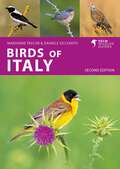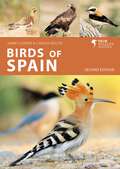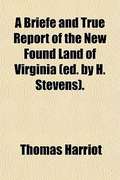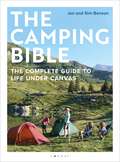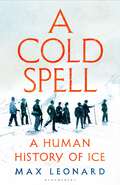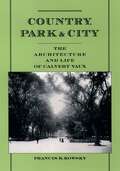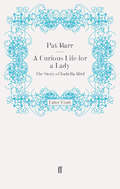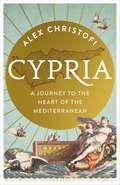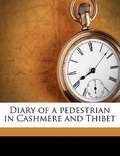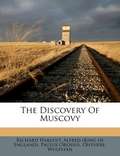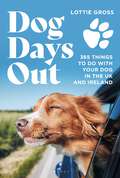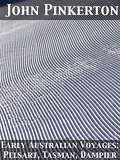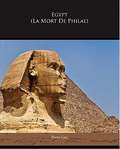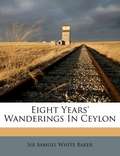- Table View
- List View
Birds of Italy: Second Edition (Helm Wildlife Guides)
by Daniele Occhiato Ms Marianne TaylorThe definitive photographic guide to the amazing avifauna of Italy.From the Alps and Dolomites in the north to the coastlines of the Mediterranean Sea, Italy has a diverse range of natural habitats. The country is also a migration path across Europe and Africa, making it an exciting place to spot both endemic and migrant birds.This fully revised and updated guide to the birds of Italy by naturalist Marianne Taylor and Italian photographer Daniele Occhiato covers more than 320 birds most likely to be seen on any visit to the country. Portable and reliable, the concise text for each species includes information on identification, songs and calls, behaviour, distribution, and habitat, with each photo carefully selected to aid identification. A guide to the best birdwatching sites in Italy is also included. This is the perfect guide for travellers and birdwatchers visiting this spectacular and bird-rich country in southern Europe.
Birds of Spain: Second Edition (Helm Wildlife Guides)
by James Lowen Carlos Bocos GonzalezThe definitive photographic guide to the avifauna of Spain. Spain is recognised as one of Europe's richest birdwatching destinations, one that offers a host of regional specialities. It includes famous birding hotspots such as the vast Coto Doñana wetlands, mountainous areas such as the Pyrenees and Picos de Europa, the Mediterranean oak forests of the south, the migration crossroads of the Strait of Gibraltar and the plains of Extremadura. Completely revised and updated, this new version of Birds of Spain provides photographic coverage of more than 320 species that regularly occur in the region, from the Hoopoe to the Golden Eagle. Concise text for each species includes information on identification, songs and calls, behaviour, distribution and habitat, with each photo having been carefully selected to aid identification. A guide to the best birdwatching sites in Spain is also included.Portable yet authoritative, this is the perfect companion for any wildlife-friendly visitor to this spectacular and bird-rich country.
A Brief and True Report of the New Found Land of Virginia
by Thomas HarriotFor more than 400 years, scholars from an array of disciplines have recognized Theodor de Bry's 1590 edition of Thomas Hariot's A briefe and true report of the new found land of Virginia as a book whose influence shaped contemporary European perceptions of North America, as well as subsequent research on that period for centuries to come. <P> <P> The book, upon which the present volume is based, is from the collections of the Library at the Mariners' Museum. It is extremely rare, containing hand-colored illustrations from the period, and is one of only three recorded copies with colored plates. This complete facsimile edition presents de Bry's exceptional engravings, based on John White's sixteenth-century watercolors, in their original hand-colored form. The book is available in paperback and as a limited cloth edition of two hundred numbered copies. Both editions are printed by the award-winning Stinehour Press. <P> <P> As the first volume in de Bry's celebrated Grand Voyages, a series of publications chronicling many of the earliest expeditions to the Americas, this book, which incorporates a 1588 text by Thomas Hariot, was illustrated and published in four languages. It became for many Europeans their first glimpse of the American continent. Accompanying the Latin facsimile is an English text. The first section is modernized from earlier versions of the English, and the second part, which accompanies the plates, is newly translated from the original Latin. <P> <P> In addition to a valuable introduction, the book includes two illuminating essays. The first, by Karen Ordahl Kupperman, examines the early American settlement and tells how a collaboration between the writer and mathematician Thomas Hariot and the artist John White (later governor of the Roanoke Colony) evolved into a rich study not only of English colonial life but of the Indian culture and the natural resources of the region. The second essay, by Peter Stallybrass, uncovers new information in the much studied plates and presents an intriguing theory about the creation and importance of the engravings. <P> <P> This facsimile edition will appeal to students and scholars in several fields of study, from American history and ethnography to fine arts and the history of the book, and will provide the reader with the best illustration of the New World as it was first presented to the Old.
California Journal
by Edgar MorinIn 1969, California is not just the new Eldorado: it is the crucible where civilisation is accelerating, self-destructs, and is reborn. It's the probe of Spaceship Earth. The hippy phenomenon, communes, the ecological movement, great collective ceremonies like park-ins and rock concerts, the flourishing of sects ranging from mystics to Marxists, the experience of 'weed' and 'acid', are temporary images and elements of a search for a new truth, a new religion, a new society. Long before it became fashionable for European intellectuals to write about their voyages to the United States, Edgar Morin, one of France's leading intellectual figures and at that time known as a path-breaking and innovative sociologist and researcher of popular culture, recounts the story of his experiences in the cauldron of change that was California, including his encounters with some of the leading minds of that time. The book combines Morin's accounts of his experiences with his own search for answers to fundamental questions about the human condition. For a few months, the author had a profound feeling of being drawn into the heart of the 'great questions', played out personally and societally. The result is an engaging and prophetic work that has as much if not more to offer today than it did when it was first published in French.
The Camping Bible: The Complete Guide to Life Under Canvas
by Jen Benson Sim BensonSlow down. Simplify. Sleep with your ear to the earth. This is the ultimate guide to the art and joy of living outdoors, under canvas. Whether it's a fast-and-light backpacking adventure, a sea kayak safari, a family camping trip, or simply living and cooking outside in your garden, camping can do it all. Offering an escape from the stresses of everyday life, the art of camping lies in living simply, well. It's about paring back our busy, hyperconnected modern lives and embracing the many joys of living more slowly and connecting more meaningfully.The Camping Bible is the complete reference for newcomers and lifelong campers alike. Discover new adventures and clever hacks for Proper Camping, sleeping close to the earth in a shelter of stretched fabric held taught by pegs and guy lines, surrounded by the sounds of nature.It includes:- a complete introduction for beginners: tent selection; pitching tips; setting up portable kitchens- family-friendly advice: making the tent a home; entertaining kids in bad weather- glamping with bell tents and tipis: how to create a luxurious experience- ideas and advice for seasoned campers: 'The Art of the Tarp', camp cookery; sustainabilityWritten by passionate and highly experienced outdoor experts, The Camping Bible is packed with wisdom, step-by-step instructions, tried-and-tested advice, top tips, recommended gear, adventure ideas, and beautiful photography and illustrations.
Car (Large Print)
This is a family car shown from the side. There is a locator dot shown, which will be at the top left of the page when the image is the right way up. The front of the car is on the left of the page and the rear is on the right. Sticking out at the very front of the car is the bumper, with the front wing housing the engine. To the right are two passenger doors each with a window and handle. At the back of the car there is a luggage compartment or boot, with the rear bumper sticking out below. Underneath the car are two wheels with hubcaps in the centre of each.
Car (UEB Contracted)
This is a family car shown from the side. There is a locator dot shown, which will be at the top left of the page when the image is the right way up. The front of the car is on the left of the page and the rear is on the right. Sticking out at the very front of the car is the bumper, with the front wing housing the engine. To the right are two passenger doors each with a window and handle. At the back of the car there is a luggage compartment or boot, with the rear bumper sticking out below. Underneath the car are two wheels with hubcaps in the centre of each.
Car (UEB uncontracted)
This is a family car shown from the side. There is a locator dot shown, which will be at the top left of the page when the image is the right way up. The front of the car is on the left of the page and the rear is on the right. Sticking out at the very front of the car is the bumper, with the front wing housing the engine. To the right are two passenger doors each with a window and handle. At the back of the car there is a luggage compartment or boot, with the rear bumper sticking out below. Underneath the car are two wheels with hubcaps in the centre of each.
A Cold Spell: A Human History of Ice
by Max LeonardTaking us from the beginning of our story to the present day, A Cold Spell examines how ice has shaped our thoughts, actions and societies – and what it means for us that it is rapidly disappearing from our planet'Bracingly original . . . As the earth warms threateningly, there could hardly be a more pertinent time for a story like this' MICHAEL PALIN'A book of limitless fascinations' OLIVIA LAING'Brightly written, nimbly researched and really quite delightful' LITERARY REVIEW'A thought-provoking chronicle of humanity . . . Leonard consistently frames ice in surprising and insightful ways, and in doing so lends it a magical quality' GEOGRAPHICALIce has confounded, delighted and fascinated us since the first sparks of art and culture in Europe and it now underpins the modern world. Without ice, we would not feed ourselves or heal our sick as we do, and our towns and cities, countryside and oceans would look very different. Science would not have progressed along the avenues it did and our galleries and libraries would be missing many masterpieces.A Cold Spell uses this vital link to understanding our past to tell a surprising story of obsession, invention and adventure – how we have lived and dreamed, celebrated and traded, innovated, loved and fought over thousands of years. It brings together a sacrificial Incan mummy, Winston Churchill's secret plans for unusual aircraft carriers, strange bones that shook Victorian beliefs about the world and a macabre journey into the depths of the human body. It is an original and unique way of looking at something that is literally all around us, whose loss confronts us daily in the news, but whose impact on our lives has never been fully explored.
Country, Park And City: The Architecture And Life Of Calvert Vaux
by Francis R. KowskyAfter beginning his architectural career in England, Calvert Vaux came to America in 1850 at the invitation of architect Andrew Jackson Downing. In 1852, he moved to New York City and asked Frederick Law Olmsted, the landscape architect, to join him in preparing a design for Central Park.During the next thirty-eight years in New York, Vaux defended and refined his vision of Central Park and pursued a distinguished architectural practice. After the Civil War, he and Olmsted led the nascent American park movement with their designs for parks in many American cities. And as apioneering advocate for apartment houses in American cities, Vaux designed buildings that mirrored the advance of urbanization in America, including early model-housing for the poor. His works also include many Gothic and Palladian style dwellings, the original portions of the Metropolitan Museum ofArt and the American Museum of Natural History, and a stunning proposal for a vast iron and glass building to house the Centennial Exhibition in Philadelphia. Most notable, perhaps, are the many bridges and other structures that he designed for Central Park. This book is the first in-depth study ofVaux's life and work.
The Cruise of the Snark
by Jack LondonThe Cruise of the Snark (1911) is a memoir of Jack and Charmian London''s 1907-1909 voyage across the Pacific. His descriptions of surf-riding, which he dubbed a royal sport, helped introduce it to and popularize it with the mainland. London writes: Through the white crest of a breaker suddenly appears a dark figure, erect, a man-fish or a sea-god, on the very forward face of the crest where the top falls over and down, driving in toward shore, buried to his loins in smoking spray, caught up by the sea and flung landward, bodily, a quarter of a mile. It is a Kanaka on a surf-board. And I know that when I have finished these lines I shall be out in that riot of colour and pounding surf, trying to bit those breakers even as he, and failing as he never failed, but living life as the best of us may live it. . from Wikipedia, The Free Encyclopedia. Intuitive navigation. . Text annotation and mark-up. .
A Curious Life for a Lady: The Story of Isabella Bird
by Pat BarrIsabella Bird was a woman of remarkable gifts. In 1872, at the age of forty, this rather earnest daughter of a country parson abandoned the rectory nest and began her pioneering journeys to some of the most inhospitable corners of the world. Undismayed by discomfort or danger she was to spend almost thirty years travelling - to the Rocky Mountains, the Sandwich Isles, to Japan, Malaya, Kashmir and Tibet, to Persia, Korea and China - where an indomitable spirit, an unassuming cordiality and, above all, a limitless capacity for being interested won her universal welcome. Her accounts of her experiences became best-selling books and established for Isabella Bird a reputation as one of the great travel writers of her day.'Miss Barr has her measure. She and Miss Bird are well suited. The style of both is fresh, energetic, visual, making an enchanting book.'Evening Standard'Rich and riotous as her intrepid heroine moves at the speed of a silent movie through landscapes lusher than any technicolour.'Times Literary Supplement'A rare book.'Sunday Telegraph
Cypria: A Journey to the Heart of the Mediterranean
by Alex ChristofiAn evocative and lyrical history of Cyprus and the Mediterranean.Think of a place where you can stand at the intersection of Christian and Arab cultures, at the crossroads of the British, Ottoman, Byzantine, Roman and Egyptian empires; a place marked by the struggle between fascism and communism and where the capital city is divided in half as a result of bloody conflict; where the ancient olive trees of Homer's time exist alongside the undersea cables which link up the world's internet.In Cypria, named after a lost Cypriot epic which was the prequel to The Odyssey, British Cypriot writer Alex Christofi writes a deeply personal, lyrical history of the island of Cyprus, from the era of goddesses and mythical beasts to the present day.This sprawling, evocative and poetic book begins with the legend of the cyclops and the storytelling at the heart of the Mediterranean culture. Christofi travels to salt lakes, crusader castles, mosques and the eerie town deserted at the start of the 1974 war. He retells the particularly bloody history of Cyprus during the twentieth century and considers his own identity as traveler and returner, as Odysseus was.Written in sensitive, witty and beautifully rendered prose, with a novelist's flair and eye for detail, Cypria combines the political, cultural and geographical history of Cyprus with reflections on time, place and belonging.
Diary of a Pedestrian in Cashmere and Thibet
by W. H. KnightNothing could exceed the beauty of the view as we approached our intended halting-place. Having crossed the torrent by a wooden bridge, the mountains we had been winding through showed out in all their grandeur, while above us, inaccessible peaks, with sharp and fanciful projections, nestled their mighty heads among the fleecy clouds, which hung about after the recent rains. ~ ~ ~ Captain William Henry Knight journeyed through Kashmir and Tibet in 1860 in the company of another officer and a porter. Having spent a year and a half in India with his regiment, Captain Knight had managed to obtain a six months' leave of absence in order to escape the hot season and journey through the cool foothills of the Himalayas. His goal in this volume was to represent "a faithful picture of travels in regions where excursion trains are still unknown, and Travelers' Guides unpublished." WILLIAM HENRY KNIGHT was a Captain in England's Forty-Eighth Regiment. This is his only known work.
The Discovery of Muscovy
by Richard HakluytIt remaineth that a large discourse be made of Moscow, the principal city of that country, and of the prince also, as before we have promised. The empire and government of the king is very large, and his wealth at this time exceeding great. And because the city of Moscow is the chiefest of all the rest, it seemeth of itself to challenge the first place in this discourse. Our men say, that in bigness it is as great as the city of London, with the suburbs thereof.
Dog Days Out: 365 things to do with your dog in the UK and Ireland
by Lottie GrossA dog-owner's bible for a wealth of fun, welcoming and quirky adventures in the UK and Ireland.A staggering one third of British households now own a dog as a pet, meaning dog-friendly days out and weekend trips are becoming ever more popular. Finding reliable and comprehensive information on dog-friendly activities, though, is getting harder thanks to the deluge of online content, much of which doesn't offer in-depth information on the kinds of things dog owners need to know. Dog Days Out solves that problem, offering 365 ideas for things to do around the UK with your four-legged friend, such as long rambles in the countryside, brilliant beaches to play fetch on, and exciting attractions and quirky accommodation options. From the rugged countryside of Ireland and Northern Ireland to the beaches of Cornwall, Kent and the Scottish Highlands, plus castles, country houses and cracking walks to be had in between, this book will provide an abundance of ideas for an hour, half a day or a whole day out to suit all weathers. Gorgeous maps and beautiful photography make this both an aspirational and endlessly useful read. The long list of brilliant activities is accompanied by essential practical information for dog owners, such as local bylaws, rules for dogs, wildlife to be aware of, safety tips, solo travel with dogs, activities with reactive dogs, and accessible dog days out.
Early Australian Voyages: Pelsart, Tasman, Dampier
by John PinkertonThe Essential Library presents John Pinkerton's "Early Australian Voyages," a captivating account of true-life stories of courage and daring. Meet the brave explorers who were the first to cross the uncharted seas.
Edinburgh: Picturesque Notes
by Robert Louis StevensonFirst published in 1879, Edinburgh: Picturesque Notes is among the most vivid of Robert Louis Stevenson’s writings. His passion for Auld Reekie never clouded his wry wit, and his enthusiasm for the picturesque detail and the savory anecdote will delight readers today as much as they scandalized his contemporaries. Perhaps best known as the author of Treasure Island and other children’s literature, Robert Louis Stevenson was a prolific novelist, playwright, essayist, and travel writer.
Egypt (La Mort de Philae)
by Pierre LotiClassic work from the French sailor who travelled extensively and achieved popularity with his impressionistic romances of adventure in exotic lands. The title refers to an ancient island temple in Upper Egypt.
Egypt's African Empire: Samuel Baker, Charles Gordon & the Creation of Equatoria
by Dr Alice Moore-HarellThis book is a detailed and original study of the creation of the province of Equatoria, located in present-day Southern Sudan. No detailed account has previously been published on the effort to conquer and create a new Egyptian province in the 1870s in the interior of Africa, despite its importance to the history of the on-going northsouth conflict in the Sudan. The annexation of Equatoria emerged from the Khedive (viceroy) Ismail's aspiration for an African empire that would control the source of the White Nile at Lake Victoria. At the time he was under pressure from the British government to suppress the lucrative slave trade in the Turco-Egyptian Sudan, and to this end the new province was to be under direct control of Cairo and not the authorities in Khartoum. The two conquering expeditions of Equatoria were led by Britons, Samuel Baker and Charles Gordon (later Governor-General of the Sudan). With them were other Europeans, Americans, Sudanese and Egyptians. Baker, Gordon and some of the others left detailed accounts of their experience in the region. All of which contribute to our knowledge not only of the difficulties involved in the annexation of a region thousands of kilometres from Cairo, but also geographical data and a record of the complex human relations that developed between the men involved in the expeditions, and the creation of the new province. Official documents from the Egyptian state archive, Dar al-Wathaiq, provide detailed accounts of the politics of the annexation of Equatoria, and these accounts are discussed in their historical context.
Eight Years' Wanderings in Ceylon
by Sir Samuel White Baker"It was in the year 1845 that the spirit of wandering allured me toward Ceylon: little did I imagine at that time that I should eventually become a settler." Baker eventually founded an agricultural settlement in Ceylon (now Sri Lanka) and found a "love for this beautiful island which can only be equaled by my affection for Old England."
